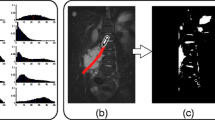Abstract
Objective
Segmentation of whole-body MRI (WBMRI) to assess the feasibility, quantitate the total tumor volume (tumor burden) in patients with neurofibromatosis type 1 (NF1) and examine associations with demographic, disease-related and anthropomorphic features.
Methods
A consecutive series of patients with NF1 underwent WBMRI and were reviewed for tumors. Tumors were segmented using a semiautomated software-based tool. Tumors were classified as superficial or deep and discrete or plexiform. Segmentation times were recorded. Segmentation yielded the quantity and tumor burden of superficial, internal and plexiform tumors. Correlations between segmentation data and demographic, disease-related and anthropomorphic features were examined.
Results
Fifteen patients were evaluated (42.3 ± 13.6 years, 10 female, 5 male). Segmentation times were a median of 30 min and yielded 2,328 tumors (1,582 superficial, 746 internal and 23 plexiform). One tumor was malignant. Tumor counts ranged from 14 to 397. Tumor burden ranged from 6.95 cm3 to 571 cm3. Individual tumor volume ranged from 0.0120 cm3 to 298 cm3. Significant correlation was found between the total volume of superficial tumors and height (ρ = 0.5966, p < 0.02). Male patients had higher overall tumor burdens (p < 0.05) and higher superficial tumor burden (p < 0.03). Patients with negative family history had more tumors (p < 0.05).
Conclusion
Segmentation of WBMRI in patients with NF1 is feasible and elucidates meaningful relationships among disease phenotype, anthropomorphic and demographic features.




Similar content being viewed by others
Abbreviations
- BMI:
-
Body mass index \( \left(\frac{mass\kern0.5em in\kern0.5em kg}{{\left( height\kern0.5em in\kern0.5em m\right)}^2}\right) \)
- MPNST:
-
Malignant peripheral nerve sheath tumor
- NF1:
-
Neurofibromatosis type 1 (also known as von Recklinghausen disease)
- STIR:
-
Short tau inversion recovery
- WBMRI:
-
Whole-body magnetic resonance imaging
References
Rasmussen SA, Friedman JM. NF1 gene and neurofibromatosis 1. Am J Epidemiol. 2000;151:33–40.
Plotkin SR, Bredella MA, Cai W, et al. Quantitative assessment of whole-body tumor burden in adult patients with neurofibromatosis. PloS one. 2012;7:e35711.
Reynolds RM, Browning GG, Nawroz I, Campbell IW. Von Recklinghausen’s neurofibromatosis: neurofibromatosis type 1. Lancet. 2003;361:1552–4.
Mulvihill JJ, Parry DM, Sherman JL, Pikus A, Kaiser-Kupfer MI, Eldridge R. NIH conference. Neurofibromatosis 1 (Recklinghausen disease) and neurofibromatosis 2 (bilateral acoustic neurofibromatosis). An update. Ann Intern Med. 1990;113:39–52.
Derlin T, Tornquist K, Munster S, et al. Comparative effectiveness of 18F-FDG PET/CT versus whole-body MRI for detection of malignant peripheral nerve sheath tumors in neurofibromatosis type 1. Clin Nucl Med. 2013;38:e19–25.
Salamon J, Mautner VF, Adam G, Derlin T. Multimodal imaging in neurofibromatosis type 1-associated nerve sheath tumors. RoFo Fortschr auf dem Gebiet der Rontgenstr und der Nuklearmed. 2015;187:1084–92.
Cai W, Kassarjian A, Bredella MA, et al. Tumor burden in patients with neurofibromatosis types 1 and 2 and schwannomatosis: determination on whole-body MR images. Radiology. 2009;250:665–73.
Dugoff L, Sujansky E. Neurofibromatosis type 1 and pregnancy. Am J Med Genet. 1996;66:7–10.
Lammert M, Mautner VF, Kluwe L. Do hormonal contraceptives stimulate growth of neurofibromas? A survey on 59 NF1 patients. BMC Cancer. 2005;5:16.
McLaughlin ME, Jacks T. Progesterone receptor expression in neurofibromas. Cancer Res. 2003;63:752–5.
Ahlawat S, Fayad LM, Khan MS, et al. Current whole-body MRI applications in the neurofibromatoses: NF1, NF2, and schwannomatosis. Neurology. 2016;87:S31–9.
Ahlawat S, Baig A, Blakeley JO, Jacobs MA, Fayad LM. Multiparametric whole-body anatomic, functional, and metabolic imaging characteristics of peripheral lesions in patients with schwannomatosis. J Magn Reson Imag. 2016;44(4):794-803.
Author information
Authors and Affiliations
Corresponding author
Ethics declarations
Conflict of interest
The authors declare that they have no conflict of interest.
Additional information
Key points
• WBMRI segmentation in NF1 is feasible in reasonable time.
• Segmentation of thin-slice WBMRI allows detailed tumor burden measurement.
• Male NF1 patients tended to have higher total body tumor volumes.
• Male NF1 patients tended to have a higher total volume of superficial tumors.
• Taller NF1 patients tended to have higher total volume of superficial tumors.
• Patients with family history of NF1 tended to have fewer tumors.
Electronic supplementary material
Below is the link to the electronic supplementary material.
Figure 1
A 45-year-old female with known NF1 and right neck swelling. (A) Coronal composed STIR image, (B) maximum intensity projection image, and (C, D) reconstructed sagittal STIR images from the same contiguous data set (3.5-mm-thick slices and 0 mm interslice gap) confirm the plexiform neurofibroma (arrows). (JPG 121 kb)
Rights and permissions
About this article
Cite this article
Heffler, M.A., Le, L.Q., Xi, Y. et al. Tumor segmentation of whole-body magnetic resonance imaging in neurofibromatosis type 1 patients: tumor burden correlates. Skeletal Radiol 46, 93–99 (2017). https://doi.org/10.1007/s00256-016-2522-4
Received:
Revised:
Accepted:
Published:
Issue Date:
DOI: https://doi.org/10.1007/s00256-016-2522-4




